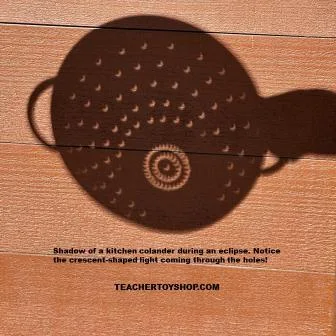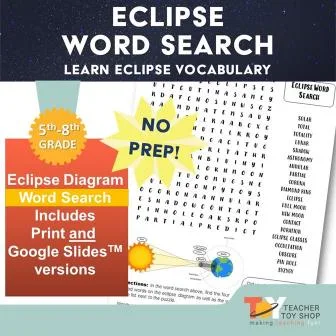"Clouds and eclipses stain both sun and moon" — William Shakespeare
With the upcoming eclipse, many people are asking for fun eclipse activities! Below are some things to do on eclipse day, as well as astronomy activities you can do to prepare your students. Almost all of these eclipse activities can be done whether you are experiencing a partial or total solar eclipse.
Eclipse Activity: Use a Kitchen Colander as a Pinhole Projector
Remember that you should never look at the sun with your bare eyes and it is not safe to use sunglasses to look at the sun! If you are going to look directly at the sun, you must use glasses specifically made for eclipse viewing. Never look directly at the sun without proper eye protection. You can seriously hurt your eyes or go blind. Please be careful so that you do not damage your eyes or the eyes of your students!
Without looking directly the sun, there is another cool way to see what is happening. Use a kitchen colander and observe the colander's shadow. Watch what happens to the shape of the light as comes through the holes of the colander.
Here is my kitchen colander:
Here is what the shadow looks like today (March 14—not an eclipse day!) as the sun streams through the holes:
Here is what the shadow looked like back on October 14th during an Annular Eclipse. See the crescent shape of light coming through all of the holes? Cool, huh?
If you plan to do this kitchen colander eclipse activity with your students, I recommend having them look at the colander's shadow before the eclipse starts so they can see a "normal" view and then they will better understand what is different and special during an eclipse. And remember, look only at the surface where the light is coming through the colander; do NOT look through the colander at the sun!
Free Printables for Eclipse Activities
There are many resources out there to teach about eclipses and to use this event as a teachable moment to teach about astronomy in general. Here is a FREE eclipse word search!
Here is a FREE printable silly fill-in reading passage about the sun.
Need to help your students understand why our Sun is the brightest object in the sky? Students will learn the difference between a planet and a star. They'll also understand why the sun appears to be the brightest star in our sky, even though it's not the biggest nor the brightest star. This funny resource will 'brighten' up your space unit and eclipse activities.
Printable Space Board Game
This printable space board game not only includes fun facts about eclipses and other space facts, but it also has jokes, rhyming poems, and space-related idioms which students love.
Ready-to-print space board game is hilarious fun! Learn about planets, stars, gravity, asteroids, the solar system, craters, orbits, eclipses, astronomy history, seasons, and more. This perfect for an earth and space science unit.
The gorgeous board prints on 4 sheets of regular paper which can be taped, glued and/or laminated together. One hundred and twenty question cards are included which are fun and funny! Some cards ask kids to complete poems, idioms, jokes, and more in addition to standards-based astronomy questions. Differentiate learning by removing cards for topics that you're not teaching.
Print enough games for the entire class to play at the same time! Students can even play at home with their families—or outside while waiting for the eclipse to start. Board games are a fantastic non-screen way to learn.
Model the Eclipse
Have your students model an eclipse. There are lots of ways to do this, and here's one great example from NASA's JPL.
Make sure to also model the difference between a solar and lunar eclipse so students understand the difference. Consider also discussing how an annular eclipse is difference from a total eclipse.
The Exploratorium also has lots of great activities for learning about and modeling eclipses.
If you have extra time outside, it's a great opportunity to make a scale model of the solar system! Here's a link to a project to do that using adding machine tape.
Eclipse Clothing as an Eclipse Activity
Wear a funny t-shirt to illustrate the difference between solar and lunar eclipses. Here's an example:
Some people are going to wear red and green on eclipse day if they are in the zone of totality. This may enhance the Purkinje Effect.
Teach Eclipse Vocabulary as an Eclipse Activity
Teach your students the word syzygy and then wish everyone a happy syzygy day! How often do you have an excuse to use such an unusual word with no fewer than three y's? Syzygy is a word for when three celestial bodies line up—such as when the earth, moon and sun line up in an eclipse.
Other words to teach that day include, crescent, totality, corona, solar, lunar, umbra and more. These words are included in the free eclipse word search linked earlier in this post.
Eclipse Activity: Watch Educational Videos
There are lots of great videos online to explain eclipses. Here's an example of one from National Geographic.
Bill Nye the Science Guy made a brief video before the 2017 eclipse. You can watch it here.
Eclipses in Culture
This post begins with a quote by William Shakespeare. There are many connections to eclipses in literature and film. For example, Mark Twain's A Connecticut Yankee in King Arthur's Court has a time traveler get out of a sticky situation by claiming he was all-powerfully blotting out the sun. Find examples in literature, film, or world mythologies and discuss.
If possible, go to an educational location such as a community college during the eclipse; it really enhances the experience! For the 2017 eclipse we were lucky enough to be at Jefferson College where they had an outstanding eclipse program, including telescopes with special filters. My son was able to take a photo through the telescope and we got this amazing photo. Yes, those are sunspots!













Post a Comment
Thanks for visiting Teacher Toy Shop. We'd love to hear your thoughts and ideas.